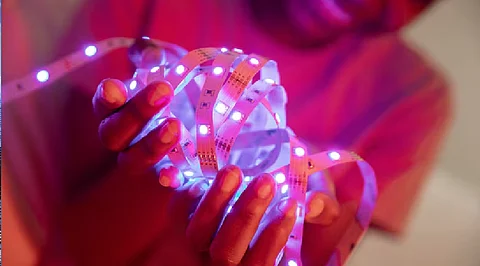

In recent years, LED strip lights have surged in popularity, transforming the way we think about lighting in homes, businesses, and industrial spaces. Their flexibility, energy efficiency, and aesthetic appeal make them a go-to lighting solution for many applications. For businesses and large-scale buyers, purchasing LED strip lights at wholesale prices is both economical and strategic. If you're exploring the world of wholesale LED strip lights, this guide will cover everything you need to know—from the basics to industry-specific tips.
LED strip lights are flexible circuit boards populated with light-emitting diodes (LEDs) that emit bright light with minimal energy usage. They typically come with adhesive backing for easy installation and can be cut or extended according to the application. Most LED strips are powered by 12V or 24V DC, and are available in various brightness levels, colors, and waterproof ratings.
Buying LED strip lights wholesale has several benefits, particularly for contractors, retailers, and large-scale project managers:
Cost Efficiency:
Wholesale pricing drastically reduces the cost per unit, saving you money especially when ordering in bulk.
Stock Consistency:
Ordering from a single supplier ensures product consistency in color temperature, brightness, and quality.
Customization:
Wholesale suppliers often offer customization options such as specific lengths, color temperatures (e.g., warm white, cool white), RGB capabilities, and more.
Business Scalability:
For retailers or e-commerce sellers, wholesale sourcing allows better profit margins and stock availability.
Before purchasing wholesale, it’s important to understand the different types of LED strip lights available:
Single Color LED Strips:
These emit one color (usually white) and are perfect for ambient lighting, task lighting, and under-cabinet setups.
RGB LED Strips:
These strips can change colors using a remote or controller, making them popular for decorative and party lighting.
RGBW & RGBCCT Strips:
An enhanced version of RGB strips, these include white LEDs for better light blending and added functionality.
Addressable LED Strips:
Each LED or group of LEDs can be controlled individually, offering advanced animation effects for signage or entertainment.
Waterproof LED Strips (IP65/IP67/IP68):
Suitable for outdoor use or humid environments like kitchens and bathrooms.
LED Strip Lights manufacturer are incredibly versatile. Common applications include:
Residential Use: Under-cabinet lighting, ceiling coves, staircase illumination.
Commercial Settings: Storefronts, showrooms, display cabinets.
Hospitality Industry: Hotels, bars, and restaurants often use RGB strips for mood lighting.
Events & Entertainment: Clubs, concerts, and party venues.
Automotive & Marine: Accent lighting for vehicles and boats.
Industrial Spaces: Warehouses and factories for low-energy, high-output lighting.
LED Density:
Measured in LEDs per meter (e.g., 30, 60, 120), higher density equals brighter and smoother lighting.
Voltage Compatibility:
Ensure you match the power supply with the strip voltage (typically 12V or 24V).
Color Rendering Index (CRI):
A CRI above 80 is considered good; it indicates accurate color representation of objects under the lighting.
Lumen Output:
This tells you how bright the strip is. High-lumen strips are better for task lighting; lower lumen ones are suited for decorative purposes.
Dimming Capability:
Not all LED strips can be dimmed. If dimming is needed, ensure the strip and controller support it.
Certifications:
Look for UL, CE, or RoHS certifications to ensure safety and environmental compliance.
Warranty & Support:
A reliable wholesale supplier should offer a warranty of at least 2 years and responsive customer service.
Finding a trustworthy supplier is key. Here’s what to look for:
Reputation: Check reviews, testimonials, and years in business.
Manufacturing Capabilities: Preferably, source from a manufacturer rather than a middleman
Customization Options: If your project requires specific specs, make sure the supplier can accommodate.
Logistics & Delivery: Efficient shipping, tracking, and packaging make a huge difference in business operations.
Samples: Request samples before placing large orders to inspect quality and compatibility.
DekingLED is a notable example of a dedicated LED strip light manufacturer offering wholesale options with strong global logistics and customization services.
Prices vary depending on the type, quality, and order volume. Here’s a rough breakdown:
Basic 12V single-color strips: $0.50–$1.20 per meter.
RGB strips: $1.00–$2.00 per meter.
RGBW or addressable strips: $2.00–$4.00 per meter.
Waterproof options: Add 10–30% to base price.
Bulk discounts usually start at 100 meters or more and increase with higher volumes.
Ignoring Voltage Requirements:
Mismatching your power supply can damage the lights or lead to inefficient performance.
Overlooking Heat Dissipation:
High-powered strips generate heat. Use aluminum channels or proper ventilation to prevent degradation.
Skipping Quality Control:
Always inspect samples before committing to large orders. Don’t assume all strips are the same just because they look similar.
Poor Planning of Controllers and Drivers:
The wrong controller can limit functionality, especially with RGB or addressable lights.
Choosing Price Over Quality:
Ultra-cheap strips often mean shorter lifespan, poor light output, or inconsistent color.
Wholesale LED strip lights offer an excellent opportunity for cost savings, creative lighting solutions, and business growth—if you know what to look for. Whether you're outfitting an office space, starting a lighting retail store, or managing a large design project, understanding the key aspects of LED strip lights is crucial.
Start by identifying your application, determining the specs you need (brightness, color, voltage, waterproofing), and then focus on selecting a reputable supplier. Ask questions, request samples, and build a relationship with your wholesaler. When chosen wisely, LED strip lights can be a game-changer—both for lighting design and for your bottom line.
